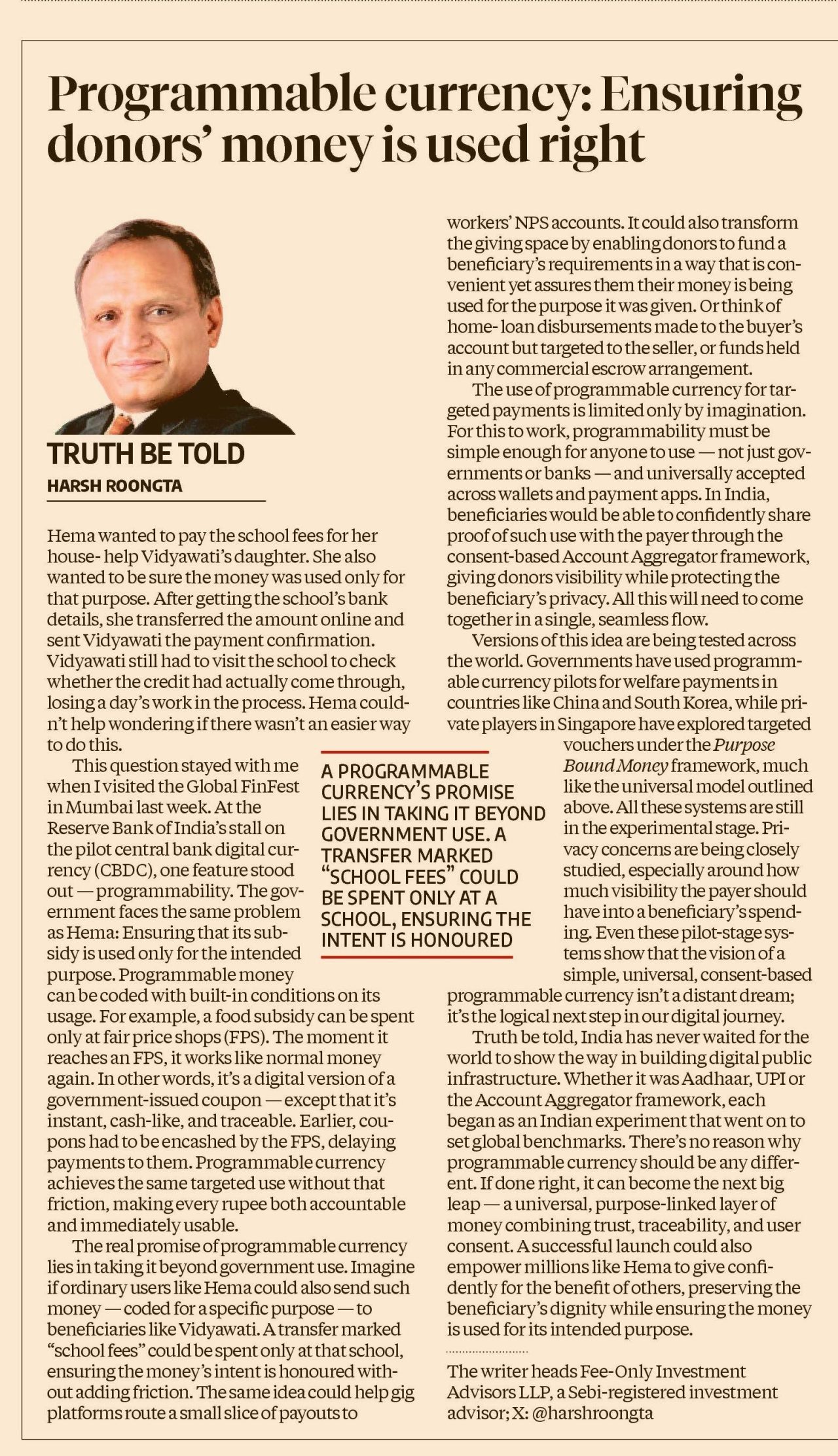
Hema wanted to pay the school fees for her house-help Vidyawati’s daughter. She also wanted to be sure the money was used only for that purpose. After getting the schools bank details, she transferred the amount online and sent Vidyawati the payment confirmation. Vidyawati still had to visit the school to check whether the credit had actually come through, losing a days work in the process. Hema couldn’t help wondering if there wasn’t an easier way to do this.
This question stayed with me when I visited the Global FinFest in Mumbai last week.
At the Reserve Bank of India’s stall on the pilot Central Bank Digital Currency (CBDC), one feature stood out programmability. The government faces the same problem as Hema: Ensuring that its subsidy is used only for the intended purpose. Programmable money can be coded with built-in conditions on its usage.
For example, a food subsidy can be spent only at fair price shops (FPS). The moment it reaches an FPS, it works like normal money again. In other words, its a digital version of a government-issued coupon except that its instant, cash-like, and traceable. Earlier, coupons had to be encashed by the FPS, delaying payments to them. Programmable currency achieves the same targeted use without that friction, making every rupee both accountable and immediately usable.
The real promise of programmable currency lies in taking it beyond government use. Imagine if ordinary users like Hema could also send such money coded for a specific purpose to beneficiaries like Vidyawati. A transfer marked school fees could be spent only at that school, ensuring the moneys intent is honoured without adding friction. The same idea could help gig platforms route a small slice of payouts to workers NPS accounts.
It could also transform the giving space by enabling donors to fund a beneficiary’s requirements in a way that is convenient yet assures them their money is being used for the purpose it was given. Or think of home-loan disbursements made to the buyers account but targeted to the seller, or funds held in any commercial escrow arrangement.
The use of programmable currency for targeted payments is limited only by imagination. For this to work, programmability must be simple enough for anyone to use not just governments or banks and universally accepted across wallets and payment apps. In India, beneficiaries would be able to confidently share proof of such use with the payer through the consent-based Account Aggregator framework, giving donors visibility while protecting the beneficiary’s privacy.
All this will need to come together in a single, seamless flow. Versions of this idea are being tested across the world. Governments have used programmable currency pilots for welfare payments in countries like China and South Korea, while private players in Singapore have explored targeted vouchers under the Purpose Bound Money framework, much like the universal model outlined above.
All these systems are still in the experimental stage. Privacy concerns are being closely studied, especially around how much visibility the payer should have into a beneficiary’s spending. Even these pilot-stage systems show that the vision of a simple, universal, consent-based programmable currency isn’t a distant dream; its the logical next step in our digital journey.
Truth be told, India has never waited for the world to show the way in building digital public infrastructure. Whether it was Aadhaar, UPI or the Account Aggregator framework, each began as an Indian experiment that went on to set global benchmarks. There’s no reason why programmable currency should be any different. If done right, it can become the next big leap a universal, purpose-linked layer of money combining trust, traceability, and user consent. A successful launch could also empower millions like Hema to give confidently for the benefit of others, preserving the beneficiary’s dignity while ensuring the money is used for its intended purpose.
The writer heads Fee-Only Investment Advisors LLP, a Sebi-registered investment advisor; X: @harshroongta
TRUTH BE TOLD Harsh Roongta a programmable currency’s promise lies in taking it beyond government use. a transfer marked school fees could be spent only at a school, ensuring the intent is honoured
Disclaimer: These are personal views of the writer. They do not necessarily reflect the opinion of www.business-standard.com or the Business Standard newspaper
(A slightly different version of this column first appeared in the Business Standard on October 20, 2025)
